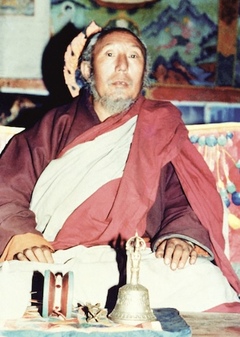Tsewang Rinpoche Biography
Literary Genres › Biography | Tibetan Masters › Pema Rigtsal Rinpoche | Tibetan Masters › Tsokhang Choktrul Rinpoche

Tsokhang Choktrul Tsewang Dorje Rinpoche
Photographer unknown
Further information:
- Pema Rigtsal Rinpoche
- Namkha Khyung Dzong Monastery
- BDRC Author Profiles: P3JM117 P7495
Brief Biography of Tsewang Rinpoche
by Tulku Pema Rigtsal Rinpoche
Venerable Tsewang Rinpoche’s father was Serta Rinpoche and his mother was Sherab Zangmo. He was recognized as a reincarnation of Tsokhang Rinpoche. He was the elder brother of Degyal Rinpoche II. From a young age, he had a sharp mind and was very diligent in his studies and contemplation.
As a result, he grew to be extremely learned. In particular, he became an expert in the tradition of Namkha Khyungdzong, in its rituals and practices, its three-year retreat format, and so on. He composed and arranged many annotations, liturgies, and ritual notations specific to the tradition. For example, annotations on the extensive, middling, and concise versions of Tröma practice, annotations on the Nyungné practice, liturgies for the Elaborate Cleansing Offering for the Gods (Gyakngen Lhasang Chenmo), liturgies for the amendment offering to the Goddess and so on, illustrations for the tormas, notes for the three-year retreats, and much more. In this way, he performed great service to the Namkha Khyungdzong teachings in general.
Tsewang Rinpoche also graciously bestowed many empowerments and transmissions. He taught the Sater Ngöndro commentary composed by Serta Rinpoche entitled The Words of the Wisdom Guru: Instructions on the Preliminary Practices of the Profound Doctrine of the Secret Heart-Essence of the Ḍākinīs. He taught The Severance Instructions of Tröma (Trömé Chötri), the quintessential elixir of the Great Secret Vehicle, the profound heart-essence of the supreme siddha Saraha. He also taught the practical instructions for practicing in volatile places for nine days, and he gave the seven-day phowa training. Once students had completed these practices, he would teach Nangjang, the Six-Month Practice of Tögal, and so on. In short, he taught the entire Tröma cycle, at least five or six times, in Humla, in Doring Khung of Purang, and other areas. I was fortunate enough to be able to receive empowerments and transmissions from him on many of these occasions. He performed exceptional service to the Namkha Khyungdzong tradition.
He also established several monasteries: in Nangwa Kuné, in Teryül in Karmarong where he established Pema Düdül Chökhor Ling Monastery, and at Surkhet where he established Pema Sangngak Chöling Monastery.
Moreover, the current Namkha Khyungdzong Monastery was the vision of my own father, Degyal Rinpoche II, but its actual construction and establishment was begun by my uncle, Tsewang Rinpoche.
In the later part of his life, driven by his concern for the teachings and sentient beings in general, and for the teachings of Namkha Khyungdzong in particular, Tsewang Rinpoche returned to Tibet, where he remained for the rest of his life. There he showed unsurpassed kindness to the several hundred students attached to Namkha Khyungdzong Monastery, and to its patrons, guiding them in both spiritual and worldly affairs.
Finally, at Chiu Monastery, the sacred practice place of Guru Rinpoche near Mount Kailash, he demonstrated parinirvāṇa. As a sign of his high accomplishment, he stayed in tukdam.[1] Later, during the cremation, many amazing signs occurred, such as a dome of rainbows appearing, and thereby the seeds of faith took root and sprouted in the minds of his students and followers.
In short, there is not a single present-day follower of the Namkha Khyungdzong tradition who is not a student of these two brothers, Tsewang Rinpoche and Degyal Rinpoche II, Pema Chöying Rangdröl. Even I, this lowly man, received the gift of the entire empowerments, transmissions, and pith instructions of the Namkha Khyungdzong Dharma tradition from these two noble siblings.
Extracted from A Garland of White Lotuses: An Account of the Teaching and Teaching Holders of the Pal Drakmar Namkha Khyungdzong Tradition.
| Translated by Laura Swan, edited by Libby Hogg, 2021. First published on Lotsawa House, 2024.
Version: 1.0-20240228
-
Tib. thugs dam. Tukdam, in this context, refers to the period following the death of an accomplished practitioner, during which time they are absorbed in luminosity. They may remain in this state for a number of days. Their body will remain soft and warm, and the usual signs of rigor mortis and so on will not occur, until the tukdam ends. ↩